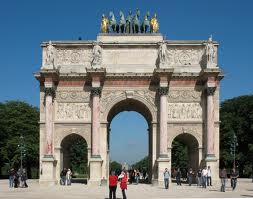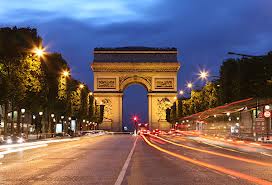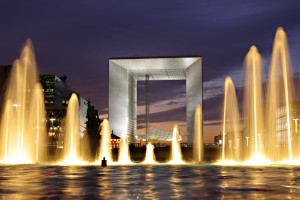The highlight of many tourists in Paris is a stroll through the Tuileries Garden from the Louvre to the Place de la Concorde, then on down the Champs-Elysées to the Place Charles de Gaulle. However, do many of them know that they are following the Triumphal Way, also known as the Historic Axis?
The Historical Axis starts and ends with arches. At the eastern end of the axis, the Arc de Triomphe du Carrousel is one of two triumphal arches on the Way. Located at the Louvre end of the Tuileries garden, it was built by Napoléon I, and modeled on the Arch of Constantine in Rome to celebrate the military might of the emperor. Originally on the top of the Arc du Carrousel were the famous horses of Saint Mark’s Cathedral in Venice, Italy, which had been captured by Napoleon in 1798. In 1815, this statuary was returned to Venice and was replaced in 1828 by a statue that commemorates the Restoration of the Bourbons after the fall of Napoléon.
At the center of the historical axis is one of the most famous monuments in Paris, the Arc de Triomphe. Sitting in the center of the Place Charles de Gaulle, the Arc de Triomphe honors those who fought and died for France in the French Revolution and the Napoleonic Wars. Also designed and commissioned by Napoleon in the same year at the Carousel arch, it took 30 years to build and was completed after his downfall.
There are names of all French victories and generals inscribed on its inner and outer surfaces, and beneath the vault lies the Tomb of the Unknown Soldier from World War I. Inspired by the Roman Arch of Titus, the Arc de Triomphe was the largest triumphal arch in existence until 1982. In 1919, Charles Godefroy flew through the center in a biplane. A rallying point for French troops after successful military campaigns, the Arc has been the site of famous military marches and parades; the Germans marched around it in 1940 when they invaded Paris. The Arc is also the starting point of the annual Bastille Day parade, celebrating French Independence Day on July 14.
The youngest arch on the historical axis is the Grande Arche de la Défense. It sits just outside the city limits of Paris in the Défense district. The idea of the arch was initiated by then French president François Mitterand, and inaugurated in July 1989 to commemorate the 200th anniversary of the French Revolution. Designed as an open cube, the Grande Arche stands for peace and humanitarian ideals instead of war victories. It is an actual functioning building, and houses many governmental offices. It is easily accessible on the RER-A.


